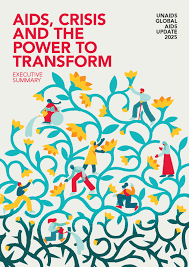
CARIBBEAN LEADS IN REDUCING AIDS-RELATED DEATHS GLOBALLY, BUT PROGRESS ON REDUCING NEW INFECTIONS SLOW

Kingston, July 10, 2025—Data from the latest Global AIDS Update Report, released by UNAIDS, shows the Caribbean recorded a 62% reduction in AIDS-related deaths, between 2010 and 2024, the steepest decline among eight regions globally.
According to the report—AIDS, Crisis and the Power to Transform, over the last fifteen years, there has been a 54% decline in AIDS-related deaths globally. The Caribbean is well above the global average at 62%. The report credits the widespread availability of anti-retroviral treatment (ART) for the progress made since 2010. Reductions have also been recorded in West & Central Africa (60%), Eastern & Southern Africa (59%), Asia & the Pacific (53%), Western & Central Europe and North America (48%), Latin America (31%) and the Middle East & North Africa (6%) while Eastern Europe & Central Asia reported a 48% increase over the same period.
UNAIDS commended governments, communities of people living with and most affected by HIV, and key partners, including PEPFAR and The Global Fund, among others for the progress made across the region. “The Caribbean’s stellar performance and achievements are commendable. It shows the resilience of a region constrained by a myriad of social, economic and other challenges such as high debt, declining external funding, and natural disasters and how critical political leadership is to safeguard people’s health without distinction,” Dr Richard Amenyah, the Director of UNAIDS Multi-Country Office in the Caribbean said. “Despite the ongoing challenges, the Caribbean continues to show that great things can be achieved when governments and all stakeholders, including people living with HIV and key populations, work together to protect and promote good health and well-being,” Amenyah said.
In 2010, only 53,000 people living with HIV were on treatment in the Caribbean. 13,000 adults and children lost their lives due to AIDS-related conditions that year. However, by 2024, this number climbed to 250,000 people on treatment—with 50,000 of them added between 2020 and 2024. Today, 85% of people living with HIV in the Caribbean know their status, 74% are on treatment, and 66% are virally suppressed (up from 33% in 2017). Last year, deaths declined to 4,800 deaths (down from 6,100 people in 2020).
While the organisation applauds stakeholders for the progress in reducing AIDS-related deaths, UNAIDS said it is concerned about the rate of decline in new infections across the region. Noting that the progress is insufficient to reach the targets to end AIDS, UNAIDS urged political leaders, healthcare workers and other stakeholders to do more to prevent new HIV infections.
Globally, new HIV infections have been reduced by 40% since 2010 but only 21% of new infections have been reduced in the Caribbean. In 2024, there were 15,000 new infections with Haiti, the Dominican Republic, Cuba, and Jamaica accounting for 90% (Haiti contributed 38%) and young people (15–24 years) account for 25% of new infections overall.
UNAIDS’ new report emphasizes integrating HIV into broader health systems, strengthening partnerships with CSOs and communities, and addressing social determinants like stigma and discrimination to prevent new HIV infections, especially among young people and key populations and prevent treatment interruptions. Caribbean governments are also being encouraged to take greater ownership to navigate geopolitical funding shifts, ensuring financial and programmatic sustainability to achieve the 2030 goal of ending AIDS.
Noting that domestic funding for the HIV response moved from 30% in 2023 to 38% in 2024, UNAIDS said more needs to be done to achieve the internationally agreed targets to end AIDS as a public health threat. “Governments must continue to prioritize increasing domestic resources, integrate HIV into broader health systems, innovate to keep people living with HIV on treatment toward achieving viral suppression and ensure equitable access for young people and key populations to prevent new infections. Only through sustained partnership and greater country ownership can we end AIDS as a public health threat by 2030 in the region,” Amenyah said.
******
Contact
UNAIDS Caribbean | Jaevion Nelson | tel. +1 876 459 3211 | nelsonj@unaids.org
UNAIDS
The Joint United Nations Programme on HIV/AIDS (UNAIDS) leads and inspires the world to achieve its shared vision of zero new HIV infections, zero discrimination and zero AIDS-related deaths. UNAIDS unites the efforts of 11 UN organizations—UNHCR, UNICEF, WFP, UNDP, UNFPA, UNODC, UN Women, ILO, UNESCO, WHO and the World Bank—and works closely with global and national partners towards ending the AIDS epidemic by 2030 as part of the Sustainable Development Goals. Learn more at unaids.org and connect with us on Facebook, Twitter, Instagram and YouTube.
WHAT IS PANCAP?
PANCAP is a Caribbean regional partnership of governments, regional civil society organisations, regional institutions and organisations, bilateral and multilateral agencies and contributing donor partners established on 14 February 2001. PANCAP provides a structured and unified approach to the Caribbean’s response to the HIV epidemic, and coordinates the response through the Caribbean Regional Strategic Framework on HIV and AIDS to maximise efficient use of resources and increase impact, mobilise resources and build the capacity of partners.
What are the Global AIDS Strategy 2021–2026 targets and commitments?
If targets and commitments in the strategy are achieved:
- The number of people who newly acquire HIV will decrease from 1.7 million in 2019 to less than 370 000 by 2025
- The number of people dying from AIDS-related illnesses will decrease from 690 000 in 2019 to less than 250 000 in 2025.
- The goal of eliminating new HIV infections among children will see the number of new HIV infections drop from 150,000 in 2019 to less than 22,000 in 2025.
What are the 95-95-95 Targets for ending AIDS?
- 95% of People Living with HIV know their HIV status;
- 95% of people who know their status on treatment; and
- 95% of people on treatment with suppressed viral loads.
HELPFUL LINKS:
Global AIDS Strategy 2021–2026, End Inequalities, End AIDS
https://pancap.org/pancap-documents/global-aids-strategy-2021-2026-end-inequalities-end-aids/
Caribbean Regional Strategic Framework on HIV and AIDS (CRSF) 2019-2025
https://pancap.org/pancap-documents/caribbean-regional-strategic-framework-2019-2025/
